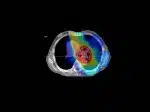
The new technique could transform lung cancer treatment.
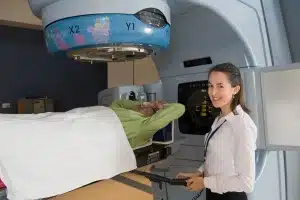
Sarah Everitt treating a patient with radiation therapy at the Peter MacCallum Cancer Centre. Credit: Monash University
“At present there is no reliable way of monitoring the effectiveness of therapy in killing lung cancer cells during treatment,” says Sarah Everitt, the lead investigator for the study, a PhD student in medical imaging & radiation sciences at Monash University, and a radiation therapist at the Peter MacCallum Cancer Centre.
“We hope this information will assist us to tailor treatment according to each individual patient.”
“It’s also important because, if only a few cells survive of the millions that make up a tumour, then we have failed to cure the patient.”
The study used a combined PET/CT scanner (positron emission tomography/ computed tomography) scanner and a novel radioactive tracer called FLT or in full…18F-3′-deoxy-3′-fluoro-l-thymidine. FLT targets cells that are rapidly dividing. Once injected, it can highlight cancers that appear not to be responding to therapy. “At present, there is no other imaging method that can achieve this,” says Sarah.
Lung cancer remains the leading cause of cancer death in Australia. The typical time of survival of patients after diagnosis is less than two years, so improved treatments are needed.
“If we observe a particularly aggressive tumour that grows rapidly during treatment, we can adapt treatment delivery based on the individual’s response. This might mean administering the treatment more quickly, or giving a higher radiation dose. Overall, we hope this will improve outcomes and survival of patients with lung cancer and possibly patients with other cancers,” says Sarah.
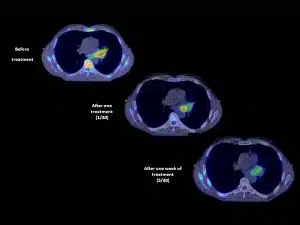
Monitoring cell proliferation in lung cancers during radiation and chemotherapy. Credit: Sarah Everitt, Peter MacCallum Cancer Centre
“These scans may also provide us with information that suggests some cancers are not responding to therapy. These patients could then be switched to a different treatment without delay.”
The results have also demonstrated how bone marrow behaves during radiation treatment. “One can easily see that bone marrow is extremely sensitive to radiation. Changes are observed after only one day’s therapy in a course of six weeks. Because bone marrow produces blood cells, the FLT PET scans could be highly valuable in monitoring patients having large areas of their body irradiated. There may also other scope for these scans, such as monitoring the effects of accidental radiation exposure”.
Sarah and her colleagues at Peter Mac, including Associate Professors Michael Mac Manus and David Ball, Professors Rod Hicks and Tomas Kron, and Dr Michal Schneider-Kolsky from Monash University, have now been granted $250,000 by the Victorian Cancer Agency to continue this study.
Sarah Everitt is one of 15 early-career scientists presenting their research to the public for the first time thanks to Fresh Science, a national program sponsored by the Federal Government.
For further information, contact Sarah Everitt on 0419 546 639 or sarah.everitt@petermac.org
For Fresh Science contact: Sarah Brooker on 0413 332 489 and Niall Byrne on 0417 131 977 or niall@freshscience.org.
Further details at www.freshscience.org.
Background information
An experimental radioactive injection can show if lung cancers continue to grow during treatment, researchers say.
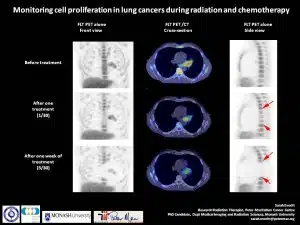
Monitoring cell proliferation in lung cancers during radiation and chemotherapy. Credit: Sarah Everitt, Peter MacCallum Cancer Centre
The radioactive tracer, known as 18F-3′-deoxy-3′-fluoro-l-thymidine (FLT), is injected into patients before they undergo a positron emission tomography/computed tomography (PET/CT) scan. The FLT travels around the body and collects inside cells that are rapidly dividing, such as tumour cells. Patients then undergo the PET/CT scan, which maps the location of FLT inside their body.
Five patients with lung cancer who underwent treatment at the Peter MacCallum Cancer Centre (Peter Mac) participated in a trial that was the first study of its kind worldwide. The trial used FLT PET/CT scans to monitor lung cancers while patients were undergoing treatment with combined radiation and chemotherapy.
Sarah Everitt, a final year PhD student at the Dept of Medical Imaging & Radiation Sciences at Monash University and a Research Radiation Therapist at Peter Mac, is the lead investigator for this study. With a background in radiation therapy, the focus of Sarah’s research is to utilise these findings to improve the effectiveness of radiation therapy treatment for lung cancer.
“When radiation therapy is prescribed with the intent of curing a patient of their lung cancer, it is typically administered five times per week for six weeks. The aim of radiation therapy is to damage the cell’s DNA so that the cells are killed and unable to continue replicating” says Sarah. However, in many patients, the treatment may only damage some cells. It is therefore important to find out if the treatment is successful in stopping the cancer cells from dividing, or not, in which case treatments may be modified for such patients.
In our trial, patients underwent FLT PET/CT scans early during treatment to explore if and how quickly their tumours were responding to therapy. Scans were also repeated several weeks into therapy to monitor if this response continued. There is also evidence that some lung cancer cells may begin to divide very rapidly in the last weeks of treatment and we were interested to explore this phenomenon also.
Lung cancer is the leading cause of cancer death in the Western World, and kills more than 7000 Australians every year. The cells that make up a lung cancer are known to grow very rapidly; quicker than many other cancers and certainly more rapidly than most normal cells in our body.
Before commencing therapy for lung cancer, patients at Peter Mac are scanned with an integrated PET/CT scanner, using a proven, routinely used radioactive tracer called 18F-fluoro-2′-deoxy-d-glucose (FDG). FDG accumulates in cells that have a high glucose metabolism, such as tumours. FDG PET/CT is currently the most accurate method available for imaging lung cancers and provides highly accurate images that tell us where the cancer is, what stage it is and where we should target the treatment.
Knowing the exact location of a cancer and its surrounding organs is absolutely essential to plan treatment that targets the radiation beams where they are needed. We aim to give the entire prescribed radiation dose to the tumour while minimising the exposure of nearby radiosensitive organs, including the surrounding normal lung tissue, the spinal cord, heart and oesophagus.
“However, although we utilise the best available technology to locate tumours in the planning phase, once the six week course of therapy actually begins there is no way of knowing if the cancer cells are responding” continues Sarah.
Images taken with linear accelerators, the machines used to treat cancer, help to ensure we are accurately targeting the tumour however they are not capable of detecting changes at a cellular or molecular level.
Although FDG PET/CT is the best proven method for imaging lung cancer it does have some limitations. FDG can accumulate in cells that are inflamed and this can be a problem when imaging patients during therapy, because cancer treatment can cause inflammation in the tumour and organs surrounding the tumour.
Using the novel tracer, FLT, has provided us with additional important information about tumours, specifically if they continue to divide or if they are responding to treatment.
Hence, this tracer holds great potential in the management of future patients receiving treatment for lung cancer.
“If we observe a particularly aggressive tumour that grows rapidly during treatment, the treatment delivery could be adapted based on the individual’s biological tumour response. This might include administering the treatment more quickly to help counteract the rapid growth, or giving a higher radiation dose.
“For the first time we have been able to look directly at the effects of chemo-radiation on the proliferation of cancer cells during a course of treatment. This is unique and enormously valuable information that could help researchers all over the world to develop new strategies aimed at improving the results of treatment of lung cancer with chemotherapy and radiotherapy,” say Michael Mac Manus who heads radiation oncology research at Peter Mac.
Even when people undergo aggressive treatment to try and cure them of their lung cancers, most will not survive longer than two years from the time they were diagnosed. We hope that results of this study will enable us to tailor therapy for each individual patient and in turn improve the outcomes and survival rates for patients with lung cancer.
“In some situations information from these scans might also suggest that some cancers are not responding or even spreading during therapy. This might indicate that these patients require a different approach to treat their cancer and they could be spared from undergoing unnecessary treatments.
Results of this research have also demonstrated how bone marrow behaves during radiation treatment.
“During treatment the radiation beams travel through various organs and bones in the patient to reach the tumour. Because cells in the bone marrow divide rapidly like cancer cells they can also be identified on the FLT PET/CT scans. One can easily see that bone marrow is extremely sensitive to radiation and changes are observed after only one day’s therapy. The usual radiation therapy continues for about six weeks.
Because bone marrow produces our blood cells, the FLT PET/CT scans could be highly valuable in the future to monitor patients having large areas of their body irradiated. There may also other scope for these scans, such as monitoring the effects of accidental radiation exposure”.
Sarah was the recipient of the 2007 Australian Institute of Radiography Research Scholarship, which was awarded to support the pilot phase of this research. Since then, Sarah and her colleagues at Peter Mac, including Associate Professors Michael Mac Manus and David Ball, Professors Rod Hicks and Tomas Kron, and Dr Michal Schneider-Kolsky from Monash University, have been awarded a Tumour Stream Research grant valued at $250,000. This grant, awarded by the Victorian Cancer Agency, is supporting the second phase of this study, which is currently underway at Peter Mac. Patients in the current study are receiving both FLT and FDG PET/CT scans to examine cellular division and glucose activity during therapy. Sarah was recently announced a joint-recipient of the 2009 Peter Mac Post-Graduate Research Medal.
“Although there remains a great deal to learn from these results, it is extremely rewarding to conduct research that has the potential to positively impact on the patients we care for”.
Alternative images:
Sarah Everitt treating a patient with radiation therapy at the Peter MacCallum Cancer Centre.

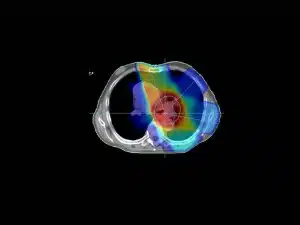



 Fresh Science is on hold for 2022. We will be back in 2023.
Fresh Science is on hold for 2022. We will be back in 2023.